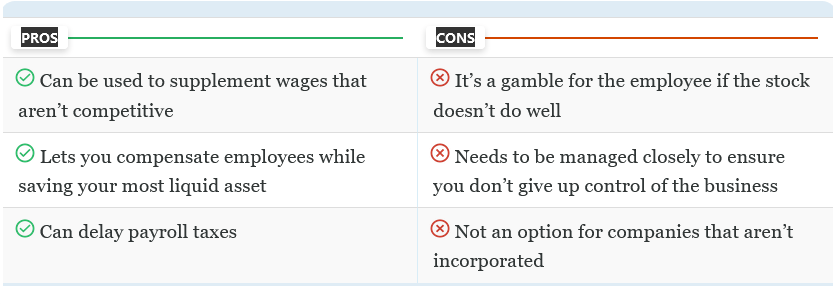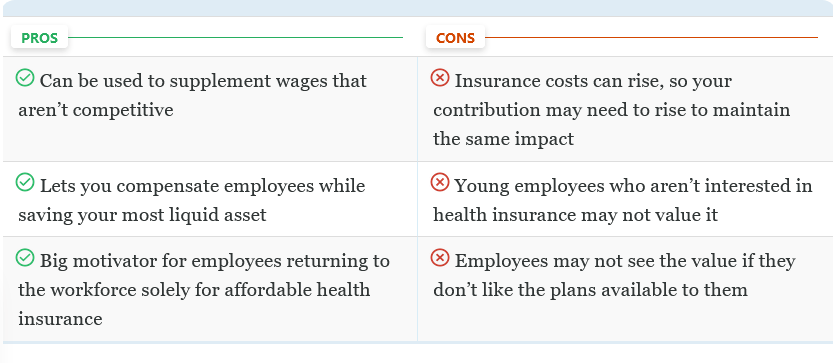Paying Your Employees: What Options Do You Have?
Employers have options when it comes to compensating their workers. In addition to the most common payment methods (direct deposit, pay cards, paper checks, and cash), there are some more creative options to choose from, such as stock compensation.
In some states, you have to offer a minimum of two different ways to pay employees or you can be fined. Each payment option has pros and cons and must be managed differently. Be sure that you follow best practices for the payment types you choose.

Tip: Keep in mind that all payment options are not permitted in all states. Before choosing the payment options you want to offer to your employees, make sure to check with your specific state’s laws and regulations.
1. Direct Deposit
Direct deposit is the most common way to pay employees, with over 93% of US workers electing to be paid this way. Direct deposit is also one of the easiest ways to pay employees if you’re using payroll software. Payroll processing is all electronic—the money moves from your bank account to your employees’—and you don’t have to do anything but review and approve it. And, as a bonus, it is usually a service that’s included at no additional cost. Some providers, like Gusto, even offer on-demand pay, meaning you can deposit part of an employee’s paycheck that they’ve earned early if they need funds before payday.
If you’re not using payroll software, you can still reap the benefits of direct deposit. You’ll just need to go through your bank to set it up. There is usually a monthly and per-check fee associated with making these direct payments, but some banks, like Wells Fargo, won’t charge you the check fee if the employee has a bank account there. Monthly fees can range from $10 to $30 or more, and check fees are usually between 50 cents to $3 each.
Some banks, like Bank of America and SunTrust Bank, are now selling full payroll services. Be sure to inquire about the payroll provider they are using so you can do your own research beforehand. They tend to use popular services like QuickBooks Payroll that you can sign up for on your own.
Tip: If you choose to use your bank’s online payroll processing option, confirm that you’re not paying extra for the same services you can get by signing up with a payroll provider directly.
Pros & Cons of Paying Employees With Direct Deposit

If you’re interested in learning more about setting up direct deposit for your employees, check out our guide.
2. Pay Card
Pay cards are a newer way employers are sending paychecks to employees. They are prepaid debit cards you can use to deposit payroll. It’s a great option to use when you have employees without bank accounts. It allows you and your workers to still reap the benefits of direct deposit while eliminating some of the cons.
Some payroll software offer payroll cards for little to nothing in cost, aside from the expense of the service itself. You can also check with your bank as many of them offer pay cards as well, and the money is FDIC insured.
Many states won’t allow employers to have pay cards be the only way for employees to receive paychecks. Be sure to check your state rules before you decide how to proceed or you could face penalties and/or litigation. Regardless, we recommend using a combination of different ways to pay employees.

With payroll cards, your employees can receive their paychecks, withdraw funds, and even make purchases.
Pros & Cons of Paying Employees With Pay Cards

If you’re interested in learning more about paying your employees with pay cards, check out our guide. For help choosing the best service, check out our guide to the best pay card providers for small businesses.
3. Paper Check
Paper checks may seem outdated to some employers, but it is still a reliable way to pay employees for their work. It’s pretty simple, depending on how you’re processing the check. You can print them using your payroll software or handwrite them yourself. Handwriting them is cheaper—unless you print checks online for free—but more time consuming, especially as your business grows.

If printing paper checks using online software, you’ll need a printer and MICR ink to get started along with having your printer settings adjusted according to the system.
If you choose to print your paychecks, it’s a good idea to ask your bank about its positive pay options. Positive pay is an automated fraud prevention feature some banks offer that matches the information on checks that are cashed (account number, amount, check number) with a list of checks you have uploaded to its system and authorized for payment. If someone attempts to cash a check from your company that you have not authorized, the bank will reject it.
Pros & Cons of Paying Employees With Paper Checks

If you’re interested in learning more about paying your employee using checks, head over to our guide.
4. Cash
Most businesses distributing paychecks in cash are small and have a handful of employees. And usually, those employees are hourly or part-time workers. Paying thousands in cash every pay period isn’t efficient, so it’s best that you check how much in total you’ll need to pay out each payday before choosing this route.
We don’t usually recommend employers pay their employees in cash due to an increase of being flagged for an audit by the IRS, but it is an option if you’re diligent about creating an audit trail. It’s important that you learn how to do payroll (taxes and all), maintain records of any payroll related debits from your bank account, and create pay stubs for both your employee and your business. Tracking your payroll using excel or even utilizing payroll templates can be a good way to stay organized.
Pros & Cons of Paying Employees in Cash

If you’re interested in learning more about how to legally pay your employee using cash, head over to our guide.
5. Stock Compensation
Paying employees in stock isn’t as common as the other ways we’ve discussed, but some employers do use it. We don’t recommend using it to pay the full paycheck amount, unless you have some sort of special arrangement and the stock has value.
Typically, it’s offered as a benefit to make the company more attractive to job candidates vs a replacement for their paycheck. Stock, especially for less established businesses, isn’t usually worth much in the beginning, so future payouts aren’t guaranteed.
One important thing to keep in mind is that you will owe payroll taxes on the stock payment just as you do for regular payroll. The only difference is that it won’t be until the stock actually vests, which means the employee has to remain with the company for a certain period of time before the stock transfer is truly theirs. Five years is a common period that many employers wait before allowing employee stock to fully vest, but there’s usually a partial vesting period around the third year.
Pros & Cons of Paying Employees With Stock

Other Ways to Add Money Back to Employee Paychecks
These last two ways won’t ever be a substitute for paying employees. In fact, many classify health insurance and discounts as employee benefits. Regardless, they are just a couple of the ways you can add money back into your employees’ paychecks.
Health Premium Contributions
Contributing toward employee health insurance plans can save employees tons of money. Any funds you contribute is akin to increasing their take-home pay, especially for those who would purchase health insurance anyway. Premiums can be expensive, some exceeding $1,000 a month, so review your budget to determine how much you can afford to pay for each employee.
You don’t have to pay the full premium amount. If you have 50 or more employees, we recommend you familiarize yourself with the Affordable Care Act. You may be getting close to being required to provide insurance for your employees; you should definitely ensure you make the minimum contribution amount that the government requires for the plans to be affordable.
A plan is considered affordable if the employee’s required contribution for the lowest cost self-only health insurance option doesn’t exceed 9.5% of their wages. If it does, you’ll need to increase the amount of your contribution to comply.
Pros & Cons of Paying Employees With Health Premium Contributions

Discounts
There are a couple of ways you can pay employees with discounts: employee discounts on products and services you sell and corporate discounts on products and services from other businesses. Employees can use these at their discretion and really capitalize on the savings if the discounts apply to purchases they already normally make.
Employee Discounts
It’s easier for some businesses to offer discounts than others—for instance, restaurants and coffee shops. Everyone eats, and employees usually take at least one break during their shift. In this scenario, it’s easy to offer a 20% discount employees can use to avoid having to pack a lunch or even cook dinner after work for their families.
You should track any discounts taken within your accounting system so you’re always aware of how much your employees are exercising this benefit. Also, note that as long as you’re offering a maximum of 20% off the regular price of your product or service, the employee won’t have to include the discount in their income (meaning it’s not taxable, a plus for both of you).
Corporate Discounts
Employers can give corporate discounts through an employee discount program. Some payroll services like ADP and TriNet provide them if you sign up for one of their products. These partnerships are already set up and give your employees access by providing promotion codes they can enter when making a purchase. The discounts are usually between 5% and 15% and may include big name companies like Enterprise Rent-a-Car and AT&T.
Another option you have is to partner directly with companies you use for your business. For instance, some businesses that issue company cellphones can negotiate lower rates because they have so many lines open. And sometimes they can pass these rates on to their employees for their personal use.
To manage it in this scenario, you would add employees’ personal cellphone lines to your account at their request and deduct a premium from their paychecks (similar to how health insurance is handled). You can contribute as much or as little as you want.
If you opt to offer a benefit in-house, be sure to have a foolproof system set up so you’re not inadvertently paying expenses for employees after they leave your company. Also, ensure employees know that the discounts are for them only, not friends and family.
Pros & Cons of Paying Employees With Discounts

Bottom Line
When it comes to paying your employees or contractors, you should choose payment methods that are best for your business and team. Some ways may seem easier on the surface, like paying your staff with cash, but cause you a headache later.
Remember, you’re responsible for withholding payroll taxes from each paycheck and tracking all earnings so you can pay your portion of employment taxes. It’s also important to make sure that you are mindful of your specific employees’ needs. Do they have bank accounts? What’s most important to them—convenience, discounts, or cash? Whatever you decide, be sure to implement a solid system to track it.
This article, written by Heather Landau and reviewed by Charlette Beasley, appeared first on Fit Small Business.

